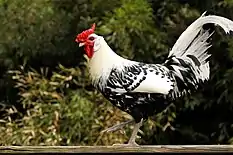Hamburg chicken
The Hamburg, Dutch: Hollands hoen, German: Hamburger, is a breed of chicken which is thought to have originated in Holland (in some sources, Hamburg, Germany) sometime prior to the fourteenth century.[6] The name may be spelled Hamburgh in the United Kingdom and Australia.[7]
 A Silver-Spangled Hamburg cock | |
| Conservation status | Watch |
|---|---|
| Other names | |
| Country of origin | The Netherlands, Germany |
| Standard | NHDB (in Dutch) |
| Use | eggs |
| Traits | |
| Weight | |
| Skin colour | white |
| Egg colour | white |
| Comb type | rose |
| Classification | |
| APA | Continental[3] |
| EE | yes[4] |
| PCGB | Soft feather: light[5] |
| |

.jpg.webp)
Characteristics
The Hamburg is a small or medium-sized breed. Cocks weigh 2–2.5 kg and hens about 1.6–1.8 kg,[1] with slender legs and a neat rose comb. Ring size is 16 mm for cocks and 15 mm for hens. Eleven different colour varieties are recognised in Germany and Holland, including silver-spangled, gold-spangled, gold-pencilled, citron-pencilled, silver-pencilled, white, black and citron-spangled;[4] six of these are included in the American standard of perfection.[3] Pencilled breeds are smallest and self-coloured birds are largest. There are also Bantam Hamburgs.[1][8]
Use

Hamburgs mature quickly and are considered good egg producers. Eggs weigh about 50 g,[1] with glossy, white shells.
In literature
Lalia Phipps Boone argued in 1949 that Chauntecleer and Pertelote, the chickens in Chaucer's "Nun's Priest's Tale," are Golden Spangled Hamburgs.[9]
L. Frank Baum was keen on Hamburgs: he started a monthly trade journal, Hamburgs, in 1880; his first book, published in 1886, was The Book of the Hamburgs: A Brief Treatise upon the Mating, Rearing, and Management of the Different Varieties of Hamburgs.
References
- Hollandse Hoenders (in Dutch). Nederlandse Hoender en Dwerghoenderbond. Archived 19 August 2014.
- Victoria Roberts (2008). British poultry standards: complete specifications and judging points of all standardized breeds and varieties of poultry as compiled by the specialist breed clubs and recognised by the Poultry Club of Great Britain. Oxford: Blackwell. ISBN 9781405156424.
- APA Recognized Breeds and Varieties: As of January 1, 2012. American Poultry Association. Archived 4 November 2017.
- Liste des races et variétés homologuée dans les pays EE (28.04.2013). Entente Européenne d’Aviculture et de Cuniculture. Archived 16 June 2013.
- Breed Classification. Poultry Club of Great Britain. Archived 12 June 2018.
- "Poultry Breeds - Hamburg Chickens". Breeds of Livestock. Oklahoma State University: Department of Animal Sciences. Retrieved 29 October 2016.
- Australian Poultry Standards, 2nd Edition
- American Poultry Association (1998). The American Standard of Perfection. Petaluma, CA: Global Interprint.
- Lalia Phipps Boone (1949). Chauntecleer and Partlet Identified. Modern Language Notes 64 (2): 78-81. (subscription required)
![]() Media related to Hamburg (chicken) at Wikimedia Commons
Media related to Hamburg (chicken) at Wikimedia Commons